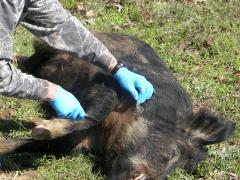|
|
| Figure 1. Hunter wearing gloves while field dressing a feral hog. Photo courtesy of Jim Cathey |
In general, feral hogs have the potential to contract and transmit all of the diseases of domestic swine. Because of this, feral hogs have the potential to function as a disease reservoir that can impact nearby domestic swine herds. Additional diseases that are contracted by feral hogs can also infect other wild and domestic mammals as well as man. Such disease impacts are the most significant and potentially most expensive type of damage that feral hogs can cause to the agricultural industry in the United States today.
Feral Hogs can carry and/or transmit several diseases to wildlife and/or humans. Three diseases that cause the most concern are swine brucellosis, psuedorabies, and tularemia, although, feral hogs harbor other diseases as well.
Swine Brucellosis
The bacterium swine brucellosis (Brucella suis) is transmitted by breeding (semen, reproductive fluids) and ingestion of the bacteria (placenta and aborted fetuses, milk and urine).
Swine brucellosis is often called undulant fever when humans contract it because body temperature rises and falls along with flu-like symptoms. Symptoms in swine include abortions, lameness, arthritis, abscesses, infertility, and sometimes death.
Swine brucellosis can cause a false positive test for bovine brucellosis (Brucella abortus) in cattle. A positive test for bovine brucellosis results in a quarantine of the cattle herd, ultimately leaving the cattle rancher with a financial loss.
Pseudorabies
Pseudorabies (Herpesvirus suis) can not be contracted by humans; however, domestic livestock and some wildlife species can be affected. The name psuedorabies implies this disease is a form of rabies, but it is actually caused by a herpes and not a rabies virus. Transmission of pseudorabies is by nose-to-nose or sexual contact, and ingestion or inhalation of the virus. Some symptoms can include abortion, mortality among piglets, coughing, and fever among adults. Itching followed by incessant scratching and biting of the skin may occur with affected cattle and dogs. Neurological symptoms may also occur, and the endpoint is death.
Tularemia
Tularemia (Francisella tularensis), also known as rabbit fever, can be contracted by humans. Tularemia is transmitted by direct contact through a wound, eating infected meat, and by ticks and biting flies that harbor this disease. Flu-like symptoms along with swollen lymph nodes are some of the symptoms when humans contract tularemia. Pneumonia, blood infections, or meningitis can be caused by severe cases.
Tularemia can survive weeks in wet environments. Texas Tech University researchers recently tested 130 feral hogs, and 50% of those tested hogs in Crosby County and 15% in Bell and Coryell Counties showed past exposure or were currently infected with tularemia.
Additional Diseases
Feral hog fecal material can transmit additional diseases, which can pose a problem when supplemental feed for livestock or wildlife is placed on the ground, increasing the chances of fecal contamination by hogs. Bacterial diseases (e.g., swine brucellosis and tularemia) are not generally spread this way, but other diseases such as salmonellosis, foot rot, intestinal bacteria, viruses, and parasites are commonly transmitted by this route.
Meat Processing and Handling
Hunters are also at risk for exposure to potential diseases from feral hogs. To limit exposure to potential diseases hunters should:
- Not process feral hogs that exhibit any signs of illness.
- Wear a double set of rubber or plastic gloves while processing and handling feral hog meat.
- Wear safety glasses while processing feral hogs to shield their eyes.
- After processing a feral hog hunters should wash their hands soap and warm water, and tools and work surfaces with a dilute bleach solution.
- Cook feral hog meat thoroughly to an internal temperature of 160°F.

